Greek Medicine and Science in the Early Middle Ages
In the Mediterranean world from the 4th to 6th centuries A.D., the geography of research and teaching, the very content of science, and the circulation of knowledge, were greatly affected by the shifting of power, and the fragmentation of the political landscape. In the East, Greek heritage flourished in the Byzantine Empire, especially in the school of Alexandria in Egypt, which became the major medical and scientific center. At the same time, some of the founding texts of Greek medicine were translated into Latin in North Africa or in Ravenna, Italy, where a school reproducing the model of Alexandria seems to have been active. New works were also being written, some of which originated in the West and were associated with the legacy of Antiquity. Many of these texts were attributed to such physicians and scientists as Hippocrates, Aristotle, and Galen.
Hippocrates
Among the works written by Hippocrates (ca. 460–ca. 375 B.C.) or in his milieu, the most popular in the Middle Ages were the Aphorisms and the Prognostic.
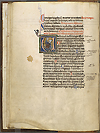
Hippocrates, as represented in a mid-thirteenth century copy of the Isagoge.
Manuscript E 78, f. 15 verso.
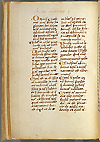
The Prognostic reflected Hippocrates' clinical activity which is characterized by attention to patients, the symptoms of their diseases, and their clinical description. It is shown here in a Medieval Latin translation.
Manuscript E 26, f. 24 recto.
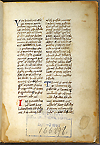
The Aphorisms, here shown in a Medieval Latin translation, are a synthesis of Hippocratic thinking and teaching expressed in the form of short maxims.
Manuscript E 26, f. 2 recto.
Aristotle
The scientific treatises by Aristotle (384–322 B.C.) were of fundamental importance in Antiquity, as well as in the Middle Ages, and in the Arabic world. In the West, the treatises were translated into Latin by philosopher and scientist Michael Scot, who worked at the court of Frederick II von Hohenstaufen in Sicily.
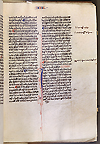
Historia animalium (Research on animals) is Aristotle's major work on zoology. It is presented here in a thirteenth century Latin translation by Michael Scot (d. ca. 1230–1235).
Manuscript E 3, f. 24 recto.
Galen
Galen (A.D.129–ca. 216), the great synthesizer of ancient medicine, left an immense oeuvre dealing with all aspects of medical science, from its philosophical fundament to therapeutics. He wrote an introduction to medicine, Technê (Medical art), which was widely diffused in the West. In addition, many other works of doubtful authenticity proliferated under his name.
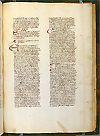
This small treatise on the supposed therapeutic properties of centaury is an example of a work credited to Galen.
Manuscript E 40, f. 137 recto.
Additional treatises
Medieval medicine relied on more than just the legacy of classical antiquity. Other Greek medical treatises, from authors and dates unknown, were assembled along with the classical works of the Greek founders of medicine and science.
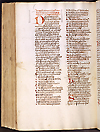
This compilation of gynecology and obstetrical material is attributed to an unknown author by the name of Cleopatra.
Manuscript E 33, f. 96 verso.
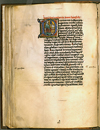
This Latin translation of a Greek treatise on the diagnosis of diseases by means of the analysis of urine is by a Byzantine physician, Theophilos.
Manuscript E 78, f. 42 verso.
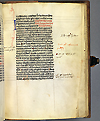
Philaretos, a Greek-speaking physician who lived at an unknown epoch in the Byzantine Empire, wrote a work on the observation of pulse to diagnose diseases. A Medieval Latin translation is presented here.
Manuscript E 78, f. 57 recto.
Last Reviewed: May 2, 2012


